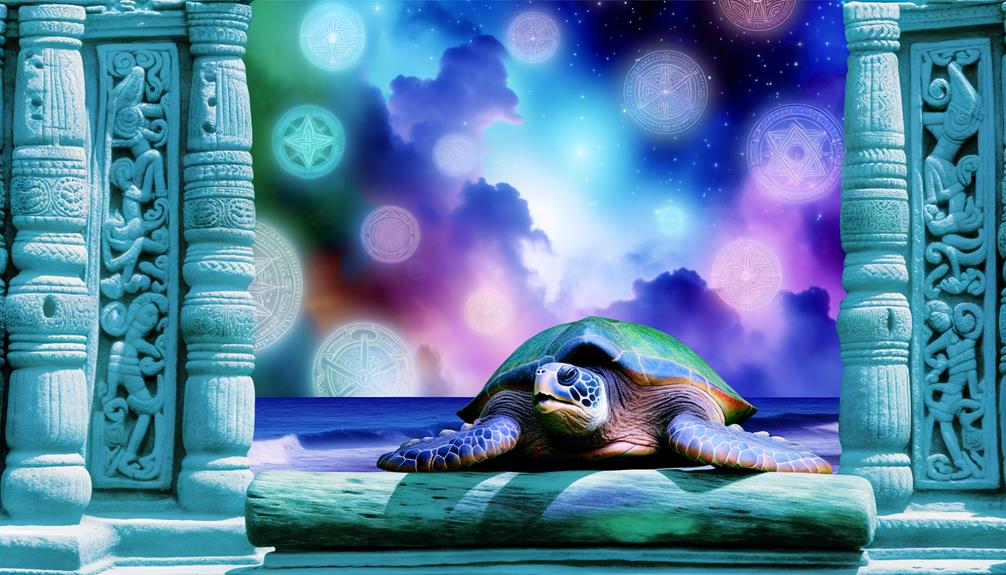What Does the Turtle Symbol Mean?
The turtle symbolizes longevity, wisdom, stability, and cosmic balance. Across cultures, it embodies perseverance and endurance.
In Chinese cosmology, its shell represents the heavens, and its underbelly signifies the earth, symbolizing cosmic order. Hindu mythology portrays the turtle as Kurma, an avatar of Vishnu supporting the world.
Native American traditions view the turtle as integral to creation myths and representative of Mother Earth. This symbolism is echoed in Japanese folklore, art, and modern environmentalism, where the turtle is an icon of good fortune and sustainability.
Explore how this ancient symbol weaves through diverse cultural narratives and beliefs.

Key Takeaways
- Turtles symbolize longevity, wisdom, and endurance.
- They represent stability and cosmic balance in various cultures.
- Turtles embody creation myths and symbolize immortality.
- They teach persistence, resilience, and the value of consistent effort.
- Turtles signify cosmic order, harmony, and interconnectedness in nature.
Native American Symbolism

In Native American symbolism, the turtle often represents longevity, wisdom, and the earth itself, deeply ingrained in various tribes' cultural narratives and spiritual beliefs.
The turtle is seen as a symbol of endurance and perseverance, reflecting the creature's long lifespan and slow, deliberate movements. Its shell, resembling the dome of the earth, carries the weight of the world, embodying stability and protection.
Among the Iroquois, the turtle features prominently in their Creation story, where the world is formed on the back of a giant turtle. This mythological significance underscores the turtle's role as a guardian of life and a vessel of ancient knowledge.
Therefore, the turtle serves as a profound emblem of interconnectedness between nature, time, and wisdom in Native American culture.
Eastern Philosophies
Revered across various Eastern philosophies, the turtle symbolizes longevity, stability, and the intricate balance of the universe, reflecting profound cultural and spiritual beliefs.
In Chinese cosmology, the turtle embodies the cosmic order, its shell representing the heavens and its underbelly the earth.
In Hinduism, the world rests on the back of a giant turtle, Kurma, showcasing the turtle's integral role in creation myths.
Japanese folklore views turtles as protectors and symbols of good fortune. Such cultural attributions evoke a deep emotional connection:
- Longevity: Inspires a quest for a long, meaningful life.
- Stability: Encourages grounding and resilience.
- Cosmic Balance: Highlights the harmony of existence.
- Protection: Instills a sense of safety and well-being.
This enduring symbolism underscores the turtle's revered status in Eastern philosophies.
Turtle in Mythology

The turtle's prominence in mythology spans various cultures, symbolizing creation and world myths. In these stories, it carries the weight of the cosmos on its back.
This ancient creature also embodies longevity and immortality, reflective of its enduring presence and slow, deliberate movement.
Moreover, the turtle imparts lessons of wisdom and patience, illustrating the virtues of persistence and thoughtful action across diverse mythological narratives.
Creation and World Myths
Across diverse cultures, the turtle often symbolizes creation and longevity, deeply embedded within various world myths and cosmologies. In many indigenous traditions, the turtle is a central figure in creation stories, embodying the idea of the Earth's formation and stability.
For instance, the Hindu myth of Kurma depicts a giant turtle supporting the cosmos during a time of turbulence. Similarly, North American Indigenous tribes regard the turtle as a foundational element in the creation of the world, envisioning the Earth carried on its back.
The cultural significance can be summarized through:
- Hindu Mythology: Kurma, the cosmic turtle.
- Chinese Mythology: Turtle as a symbol of the universe.
- Native American Lore: Turtle Island creation myth.
- African Folklore: Turtles as creators and tricksters.
This rich tapestry of myths underscores the turtle's profound role in human storytelling.
Longevity and Immortality Symbolism
In many cultures, the turtle is revered as a powerful symbol of longevity and immortality, representing an enduring presence that surpasses the fleeting nature of human life.
Across various mythologies, like in Chinese and Native American traditions, turtles are often portrayed as ancient, wise beings whose long lifespans and slow, intentional movements indicate a life of resilience and steadfastness.
The turtle's tough shell is symbolically viewed as a defense against the effects of time, enabling it to exist beyond typical temporal limits. This symbolism is further emphasized by the turtle's dual nature, being both aquatic and terrestrial, symbolizing a balance between two worlds, thereby embodying the eternal continuity of life.
Such cultural representations highlight the turtle's esteemed position as a timeless creature.
Wisdom and Patience Lessons
Building on the turtle's emblematic association with longevity and immortality, its representation in mythology also imparts profound lessons in wisdom and patience, reflecting its methodical and enduring approach to life.
Across various cultures, the turtle is venerated as a symbol of sagacity and resilience. For instance, in Native American lore, the turtle embodies the Earth, underscoring stability and persistence. In Chinese mythology, it is one of the Four Celestial Animals, signifying steadfastness and longevity. Hindu mythology reveres the turtle as the avatar Kurma, who supports the world during cosmic upheavals.
These mythological narratives convey essential life lessons:
- Resilience in adversity
- Steadfast pursuit of goals
- Balanced life approach
- Enduring wisdom
Such cultural depictions enrich our understanding of the turtle's symbolic significance.
Wisdom and Longevity
The turtle has long been revered across various ancient cultures for its embodiment of wisdom and longevity. It often symbolizes patience, resilience, and a life of measured deliberation. Its enduring presence in mythology and folklore underscores the importance of these qualities, offering profound life lessons on the virtues of slow and thoughtful progress.
Ancient Cultural Significance
Across various ancient cultures, the turtle has been venerated as a powerful symbol embodying wisdom and longevity, often depicted in mythologies and sacred texts to illustrate its revered status.
In Chinese culture, the turtle represents endurance and the cosmic order, featuring prominently in creation myths as a bearer of the world.
In Hindu mythology, the turtle is an avatar of Vishnu, embodying divine protection and stability.
Native American traditions regard the turtle as a symbol of Mother Earth, emphasizing the importance of living in harmony with nature.
Ancient Greek culture saw the turtle as a symbol of fertility and patience, reflecting the creature's slow and deliberate movement.
Symbolic Life Lessons
In the domain of symbolic life lessons, the turtle's embodiment of wisdom and longevity offers profound insights into the virtues of patience, resilience, and the enduring nature of life. This symbolism is deeply rooted in various cultural narratives where the turtle's slow, deliberate movement underscores patience and thoughtful progress.
In many traditions, the turtle's long lifespan is emblematic of wisdom accumulated over time, advocating for a steady, composed approach to life's challenges. Its resilient shell signifies protection and perseverance, suggesting that true strength lies in enduring hardships without haste.
These attributes collectively highlight the timeless principle that life's most valuable qualities—wisdom, longevity, and resilience—are cultivated through enduring patience and persistent effort, rather than through rapid, fleeting endeavors.
Persistence and Endurance

Renowned for its methodical pace and unwavering determination, the turtle epitomizes persistence and endurance across various cultural narratives and symbolic interpretations. This ancient creature's slow but steady journey through life offers profound lessons in resilience and tenacity.
The turtle's symbolism can be seen in multiple contexts:
- Cultural Mythology: In many traditions, the turtle symbolizes a steadfast approach to life, teaching the value of consistent effort over fleeting success.
- Environmental Adaptability: Turtles have survived for millions of years, embodying adaptability and endurance amid changing ecosystems.
- Personal Growth: The turtle's journey mirrors individual perseverance in the face of obstacles, promoting a mindset of gradual progress.
- Philosophical Wisdom: Philosophers often invoke the turtle to illustrate the virtues of patience and long-term thinking.
These facets highlight the turtle's enduring significance.
Cosmic Order
The turtle is often revered as a symbol of cosmic order, representing the intricate balance and harmony inherent in the universe. Across various cultures, the turtle's slow, deliberate movement and enduring presence are seen as metaphors for universal equilibrium and stability.
| Culture | Symbolic Meaning | Representation |
|---|---|---|
| Native American | Earth and Sky Connection | Shell as the universe |
| Hindu | World Support | Turtle holding the Earth |
| Chinese | Longevity and Cosmic Balance | Shell patterns |
| African | Wisdom and Cosmic Truth | Turtle's life cycle |
These cultural interpretations highlight the turtle's role in maintaining and exemplifying the natural order, signifying the interconnectedness of all cosmic elements. Through its symbolism, the turtle imparts essential lessons about the importance of harmony and order in the grand tapestry of life.
Creation and Sustenance

How does the turtle, a creature revered across numerous cultures, embody the profound themes of creation and sustenance through its enduring symbolism and mythological narratives?
The turtle is often seen as a primordial being, carrying the world on its back in mythologies such as those of Native Americans and Hindus. This emblematic creature signifies life's cyclical nature and ongoing support for the world's existence. Its longevity and resilience further symbolize stability and perseverance.
Consider these powerful visualizations:
- A world on the turtle's back – Reflecting the Earth's creation and the cosmos' support.
- Laying numerous eggs – Symbolizing fertility and life's perpetuation.
- Steady, unwavering gait – Representing unwavering support and sustenance.
- Ancient wisdom – Evoking the timeless guidance sustaining generations.
This rich symbolism underscores the turtle's cultural significance in creation and sustenance narratives.
Tranquility and Peace
The turtle, often seen as a symbol of tranquility and peace, embodies calmness and serenity through its slow, deliberate movements and enduring nature.
In various cultures, the turtle's unhurried pace is emblematic of inner peace, encouraging a reflective and measured approach to life.
This symbolism resonates deeply within spiritual traditions, where the turtle's presence is a reminder to cultivate a tranquil mind and soul amidst life's turbulence.
Calmness and Serenity
In many cultures, the turtle is revered as an emblem of calmness and serenity, symbolizing a life of tranquility and peace. This ancient creature's slow, deliberate movements evoke a sense of deliberate purpose, fostering a mindset that values patience and reflection.
The cultural significance stems from its long lifespan and ability to withdraw into its shell, representing protection and enduring wisdom. Turtles are often seen as a reminder to embrace a serene pace of life, even amidst chaos.
Consider the emotional resonance of the turtle symbol:
- A gentle reminder to slow down.
- An emblem of enduring wisdom and longevity.
- A symbol of protection and introspection.
- A beacon of peace in turbulent times.
Understanding the turtle's symbolism enriches our appreciation for tranquility and calm.
Inner Peace Symbolism
Building upon the turtle's emblematic association with calmness and serenity, its representation as a symbol of inner peace highlights a profound cultural and philosophical understanding of tranquility and peace.
The turtle's slow and deliberate movements serve as a metaphor for mindfulness and introspection, encouraging individuals to adopt a pace of life that fosters mental clarity and emotional stability.
In various cultures, such as Native American and Eastern traditions, the turtle is revered as a guardian of the soul, embodying the virtues of patience and endurance.
This animal totem invites individuals to retreat into their inner sanctum, much like the turtle withdraws into its shell, promoting a balanced state of mind that remains undisturbed by external chaos.
Turtles in Art

Depicted in a myriad of artistic mediums, turtles have long served as powerful symbols in various cultures, representing attributes such as longevity, stability, and wisdom. These creatures appear in an array of art forms, from ancient carvings to contemporary paintings, each embodying profound cultural significance and emotional resonance.
- Ancient Sculptures: Intricately carved turtle effigies found in Mesopotamian and Native American cultures symbolize the earth and creation.
- Asian Art: In Chinese and Japanese art, turtles are often depicted with cranes, symbolizing long life and good fortune.
- Oceanic Craft: Polynesian tattoos featuring turtles convey protection and fertility, deeply rooted in local mythology.
- Renaissance Paintings: European artists incorporated turtles to evoke themes of patience and perseverance.
These artistic representations underscore turtles' enduring symbolism across time and geography.
Modern Interpretations
Modern interpretations of turtle symbolism often integrate contemporary environmental concerns with the animal's traditional representations of resilience and continuity.
In an era marked by climate change and biodiversity loss, turtles are increasingly seen as icons of ecological preservation and sustainability. Their slow, deliberate movement and long lifespans serve as poignant reminders of the need for mindful stewardship of natural resources.
Additionally, the turtle's enduring presence across various cultures underscores its role as a symbol of intergenerational wisdom and stability. This fusion of ancient symbolism with modern environmentalism enriches the turtle's cultural significance, positioning it as a potent emblem in both ecological advocacy and philosophical reflection on human-nature relationships.
Consequently, the turtle remains a multifaceted symbol, relevant to contemporary societal challenges.
Conclusion
The turtle symbol intriguingly traverses diverse cultural landscapes, epitomizing wisdom, longevity, persistence, and peace.
Coincidentally, its presence in Native American folklore, Eastern philosophies, and global mythologies underscores a universal reverence. This convergence highlights the turtle's enduring significance in human consciousness, reflecting values of creation, sustenance, and tranquility.
Artistic depictions and modern interpretations further reinforce its emblematic role, cementing the turtle as a symbol of profound cultural importance and continuity across different societies and epochs.




